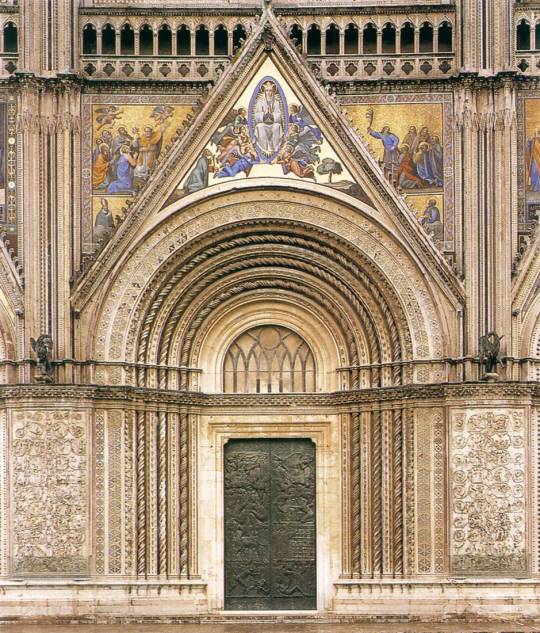—
Official protocol of the City of Orvieto, 16 September 1310, Archive of the Community of Orvieto, Deliberations of the Commune from 1310-1312, fol. 67v.
Contained in an official protocol signed in Orvieto on 16 September 1310, this is the second known documentary reference to Lorenzo Maitani, a master mason first recorded in Siena in a land registry declaration of 1290. The protocol concedes the citizenship of Orvieto and the role of “general head master” of the construction of Orvieto cathedral to Maitani, stipulating that he would also enjoy the right to carry arms within the city, and the freedom to employ as many of his apprentices and collaborators as he choose on the cathedral work site. These privileges were intended as a demonstration of the Orvietan citizens’ love for the master, who had already worked at the cathedral for about two years.
The document reveals that Maitani had originally been called to the city at a time of great distress, when the recently-completed nave of the new cathedral seemed on the brink of collapse. To the satisfaction of his contemporaries, Maitani added four buttresses to the side chapels of the transept area. The cathedral continues to stand, although twentieth-century studies have cast doubt on the necessity and effectiveness of Maitani’s intervention.
Archeological evidence — an inscription on one of the nave’s decorated roof beams — confirms Maitani’s early involvement in the roofing of the space, echoing the protocol’s description of the artist as “thoroughly expert in buttresses, roof and wall figured with beauty.”
Written in a loosely-constructed Latin greatly influenced by contemporary vernacular, the contract’s text is however unclear regarding Maitani’s work after 1310. The text clearly states that Maitani was going to work on the cathedral’s facade; yet, it is not clear if he had to complete a pre-existing and partially-completed project, or start a completely new construction. This question has been widely debated by scholars; similarly, there is no agreement on whether Maitani was also a sculptor who personally carved some of the facade’s reliefs.
Yet overall, Maitani is almost universally associated with the final form of the lower parts of the facade, up to the gallery level. He is also considered the author of one of two surviving drawings of this part of the church, an ink-on-parchment project described in an inventory of 1356 as a ‘large parchment of the facade of the church of Santa Maria Maggiore drawn by Master Lorenzo Maitani.’
References: Gillerman, David M. “The Evolution of the Design of Orvieto Cathedral, Ca. 1290-1310.” Journal of the Society of Architectural Historians 53, no. 3 (1994): 300-21; Catherine Harding. “Maitani, Lorenzo.” Grove Art Online. Oxford University Press, http://www.oxfordartonline.com/subscriber/article/grove/art/T053292.
Click here for a transcription of the entire protocol in Latin.
Façade of the Duomo, Orvieto, 1310-30 (with later restorations). Source: Web Gallery of Art.
Central portal of west facade, 1310-30 (with later restorations). Source: Web Gallery of Art.
Detail: first pillar: stories from Genesis, 1310-30. Source: Web Gallery of Art.
Detail: fourth pillar: the Last Judgement, 1310-30. Source: Web Gallery of Art.
Ink-on-parchment drawing of the facade of Orvieto Cathedral, attributed to Lorenzo Maitani, c. 1310, Museo dell’Opera del Duomo (MODO), Orvieto. Source: Museo dell’Opera del Duomo.




